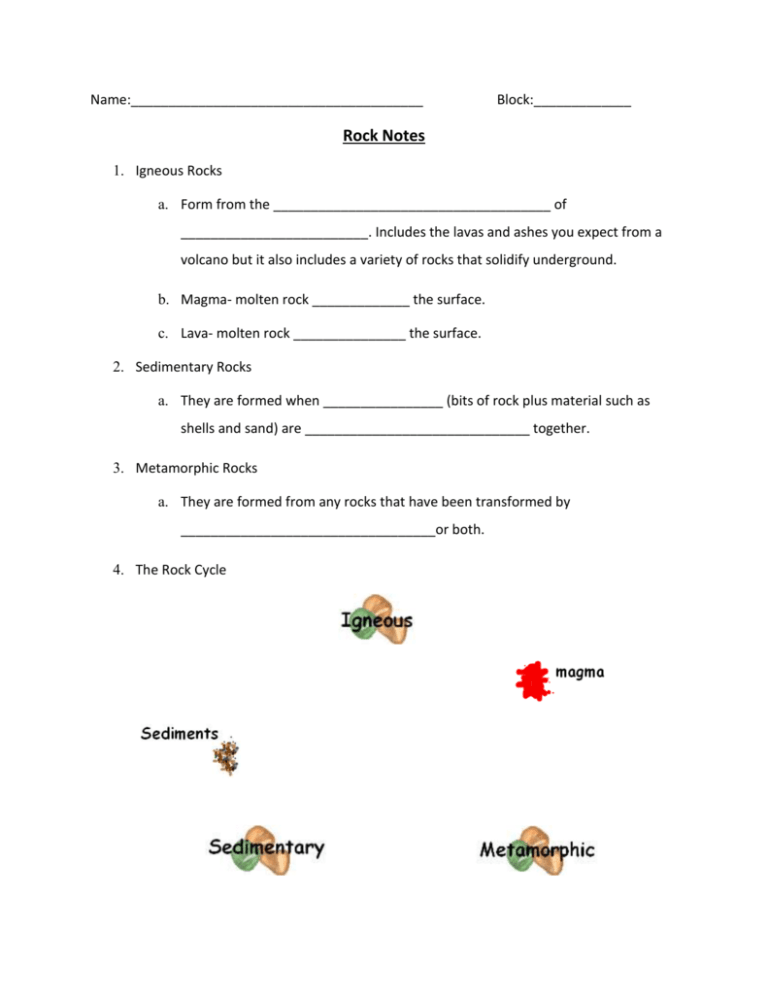Rock Notes
advertisement

Name:_______________________________________ Block:_____________ Rock Notes 1. Igneous Rocks a. Form from the _____________________________________ of _________________________. Includes the lavas and ashes you expect from a volcano but it also includes a variety of rocks that solidify underground. b. Magma- molten rock _____________ the surface. c. Lava- molten rock _______________ the surface. 2. Sedimentary Rocks a. They are formed when ________________ (bits of rock plus material such as shells and sand) are ______________________________ together. 3. Metamorphic Rocks a. They are formed from any rocks that have been transformed by __________________________________or both. 4. The Rock Cycle Add an arrow to indicate each of the following: Red arrow from magma or lava to igneous rocks. Label it cooling/crystallization/solidification. Brown arrow from igneous, metamorphic and sedimentary to sediments. Label it erosion and deposition. Orange arrow from sediments to sedimentary. Label it compaction and cementation. Green arrow from igneous, sedimentary and metamorphic to metamorphic. Label is heat/pressure/chemical action. Blue arrow from igneous, sedimentary and metamorphic to magma or lava. Label it melting. 5. Identifying the Rock Type a. Igneous rocks are recognized by: i. the __________________________________ of the grains ii. the presence of _________________ (holes) in _______________ igneous rocks iii. may be dark-colored and heavy iv. may display _____________________, one much larger than the other b. Sedimentary rocks are recognized by: i. grains ______________________ together ii. the presence of ___________________ iii. light-colored and light weight iv. may display interlocking grains but is very light weight c. Metamorphic rocks are recognized by: i. the interlocking texture of large grains ii. ___________________________________ iii. _______________ light and dark colors iv. "ching" sound instead of a "chunk" sound when tapped 6. Igneous Rock Types a. Felsic Magma- ________________________ and contains large amounts of silica b. Mafic Magma- hotter, _______________, and more ___________ and contains large amounts of iron and magnesium. c. Extrusive igneous rocks- lava ______________________________ and harden rapidly. This does ______________ large crystals to form. Can have a fine texture or glassy texture. d. Intrusive igneous rocks- magma cools __________________________. Because it cools slowly, ________________ form and cause the rock to have a _____________ texture. 7. Igneous Rock Features a. A pluton is a rock mass that forms when __________ cools inside Earth's interior. b. Batholith-_________________ and often forms the core of many mountain ranges. Usually made of granite and can be exposed by uplift and erosion. c. Laccolith-formed when magma is stiff and bulges upward to form a __________. d. Dike-sheet of igneous rock that __________________ rock layers through cracks. e. Sill-sheet of igneous rock that is _______________________________________. 8. Igneous Rock Examples: a. Granite, Scoria, Pumice, Basalt, Gabbro, Obsidian 9. Sedimentary Rock Types a. __________sedimentary rocks are formed from __________ of ____________. They can be the size of pebbles, gravels, grains of sand, tiny particles of silt, or microscopic flakes of clay. i. Conglomerate, Sandstone, Shale b. __________sedimentary rocks are formed when _________________________ in the water in lakes, swamps, and underground reservoirs get into sediments. i. Rock salt, limestone, rock gypsum c. ___________sedimentary rocks form from sediments consisting of the remains of ____________________. i. Organic limestone, chert, coal 10. Features of Sedimentary Rocks a. ______________________ is the arrangement of visible layers. b. _____________ are formed when a dead plant or animal is buried by sediments and gradually turn into rock. 11. Types of Metamorphic Rocks a. Parents rocks- the __________________________ before the heat and pressure. As a result, a metamorphic rock often resembles the parent rock. Sandstone Shells Shale Marble Slate Granite b. Foliated - ________________ due to intense ___________________ they experience deep underground. ________________________________________ become oriented perpendicular to the directions of pressure. Increasing temperature can cause minerals to recrystallize into larger crystals. c. Nonfoliated- ____________________________ because they were exposed to high temperature conditions, but not to high directional pressure. Tend to be highly ____________________________ because of the high temperatures.








